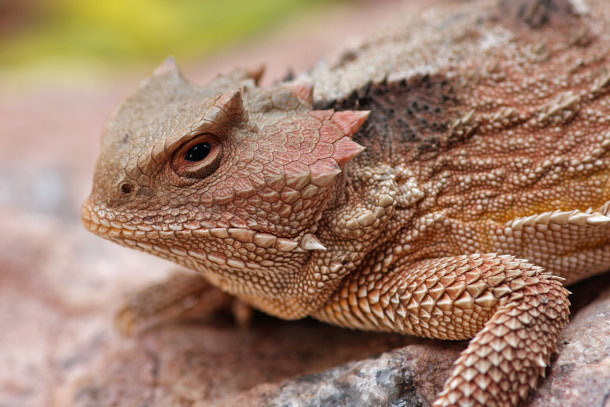Note on Emerging Science: Why Do Some Lizards and Snakes Have Horns?
Air Date: Week of July 12, 2024

Species like the Saharan horned viper may have horns to aid in camouflage. (Photo: Richard Castell, Castell Ecology, Flickr, CC BY-NC 2.0)
Snakes and lizards have independently evolved horns or spikes on their heads at least 69 times, and recent research finds evidence that horns may provide camouflage for predators that ambush their prey rather than actively chasing it. Living on Earth’s Don Lyman has this note on emerging science.
Transcript
O’NEILL: It’s Living on Earth, I’m Aynsley O’Neill
DOERING: And I’m Jenni Doering.
In a moment, we’ll turn a page in the history books with Peter Dykstra, but first this note on emerging science from Don Lyman.
[SCIENCE NOTE THEME]
LYMAN: Some snakes and lizards have horns or spikes on their heads – but why?
In the past, studies have hypothesized that these horns might be for courtship, defense, or camouflage. A team led by herpetologist Federico Banfi from the University of Antwerp wondered if the presence or absence of horns might come down to hunting style.
The scientists determined that most horned snakes and lizards remain still and ambush their prey, rather than actively pursuing it. They hypothesized that horns and spikes might provide camouflage to sit and wait predators, but could make more active snakes and lizards easier for predators and prey to spot.
The researchers looked for evolutionary clues. If the horns didn’t provide a camouflage benefit in active hunters, they might not evolve as often as in sit and wait predators.
With the help of an evolutionary tree, the team found that lizards and snakes independently evolved horns on the top of their heads, eyebrows, or snouts at least 69 times.

A greater short horned lizard sunbathes on a rock. (Photo: Carla Kishinami, Flickr, CC BY-NC-ND 2.0)
That said, horns or spikes on these reptiles aren’t the norm and only adorn less than 10% of the species the scientists analyzed. But among those horned lizards and snakes, the vast majority, or 94%, were the “sit and wait” kind of predator as opposed to those that actively move around while hunting.
It’s still possible that horns also serve some other benefit, like looking cool to a potential mate. We haven’t been able to reach any lizards to ask.
That’s this week’s note on emerging science. I’m Don Lyman.
Links
Read the full study on the evolutionary development of horns in lizards and snakes
Living on Earth wants to hear from you!
Living on Earth
62 Calef Highway, Suite 212
Lee, NH 03861
Telephone: 617-287-4121
E-mail: comments@loe.org
Newsletter [Click here]
Donate to Living on Earth!
Living on Earth is an independent media program and relies entirely on contributions from listeners and institutions supporting public service. Please donate now to preserve an independent environmental voice.
NewsletterLiving on Earth offers a weekly delivery of the show's rundown to your mailbox. Sign up for our newsletter today!
 Sailors For The Sea: Be the change you want to sea.
Sailors For The Sea: Be the change you want to sea.
 The Grantham Foundation for the Protection of the Environment: Committed to protecting and improving the health of the global environment.
The Grantham Foundation for the Protection of the Environment: Committed to protecting and improving the health of the global environment.
 Contribute to Living on Earth and receive, as our gift to you, an archival print of one of Mark Seth Lender's extraordinary wildlife photographs. Follow the link to see Mark's current collection of photographs.
Contribute to Living on Earth and receive, as our gift to you, an archival print of one of Mark Seth Lender's extraordinary wildlife photographs. Follow the link to see Mark's current collection of photographs.
 Buy a signed copy of Mark Seth Lender's book Smeagull the Seagull & support Living on Earth
Buy a signed copy of Mark Seth Lender's book Smeagull the Seagull & support Living on Earth

